
|
New comet discovered by Rob Matson from SWAN images of mid November. It can be a re-discovery of a lost comet C/1827 M1 (Pons-Gambart). Now it is very bright as 8.6 mag (Dec. 8, Juan Jose Gonzalez). It locates extremely low in the evening, and will be unobservable soon. In the Northern Hemisphere, it will appear in the morning sky at 10 mag in mid January, then it keeps observable in excellent condition while fading. In the Southern Hemisphere, it must have been locating high from summer to autumn, but it has not been discovered. After this, it is only observable in low sky from February to March.
Date(TT) R.A. (2000) Decl. Delta r Elong. m1 Best Time(A, h)
Dec. 8 19 9.17 -23 2.8 1.538 0.840 29 8.8 18:18 ( 57, 6)
Dec. 15 19 3.86 -18 44.0 1.636 0.815 22 8.7 18:20 ( 65, 2)
|
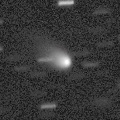
|
It is expected to be a great comet of -1 mag in 2013 spring. It brightened up to 10.1 mag in 2012 autumn (Oct. 14, Marco Goiato). It brightened faster than originally expected. It is not observable now. In the Southern Hemisphere, it will appear in the morning low sky at 8 mag in late December. In the Northern Hemisphere, it keeps unobservable for a long time until 2013 March, when the comet will appear as a 0-mag great comet.
Date(TT) R.A. (2000) Decl. Delta r Elong. m1 Best Time(A, h)
Dec. 8 16 27.06 -34 54.9 2.928 1.988 14 9.3 5:25 (300,-18)
Dec. 15 16 39.63 -36 5.2 2.795 1.875 16 9.0 5:30 (304,-15)
|
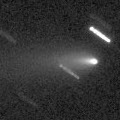
|
Now it is so bright at 9.9 mag (Nov. 24, Seiichi Yoshida). It is expected to approach to the earth and to be observable at 8 mag in good condition in winter. The condition is good in the Northern Hemisphere. In the Southern Hemisphere, it is not observable now. But it will become observable in good condition after 2013 January.
Date(TT) R.A. (2000) Decl. Delta r Elong. m1 Best Time(A, h)
Dec. 8 13 45.53 48 54.1 0.715 1.152 83 9.6 5:25 (233, 52)
Dec. 15 13 9.28 54 1.4 0.549 1.171 95 9.1 5:30 (220, 61)
|
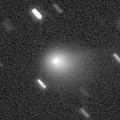
|
It brightened up to 9.0 mag in 2012 autumn (Nov. 4, Juan Jose Gonzalez). It is not observable now. In the Southern Hemisphere, it will appear in the morning sky at 9 mag in 2013 February, then it keeps observable in good condition while fading slowly. In the Northern Hemisphere, it is hardly observable after 2013.
Date(TT) R.A. (2000) Decl. Delta r Elong. m1 Best Time(A, h)
Dec. 8 17 18.46 -20 27.7 2.841 1.862 4 9.2 18:18 ( 74,-13)
Dec. 15 17 34.45 -22 46.7 2.829 1.845 1 9.2 18:20 ( 74,-17)
|
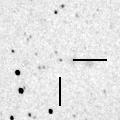
|
Getting brighter much faster than expected. Now it is so bright as 11.3 mag and visible visually (Nov. 22, Juan Jose Gonzalez). It will approach to the sun down to 0.73 A.U. in 2013 March. It may brighten up to 3 mag at best. In the Southern Hemisphere, it keeps observable while brightening gradually after this in good condition. In the Northern Hemisphere, it is only observable until early January when it becomes 9 mag. After 2013 May, it keeps observable in good condition while fading gradually.
Date(TT) R.A. (2000) Decl. Delta r Elong. m1 Best Time(A, h)
Dec. 8 11 47.57 -19 2.7 2.062 1.994 72 11.5 5:25 (339, 33)
Dec. 15 11 53.65 -23 8.2 1.876 1.897 76 10.9 5:30 (347, 31)
|

|
Now it is bright as 11.4 mag (Oct. 15, Chris Wyatt). It is expected to be observable at 11-13 mag for a long time from 2012 summer to 2013 summer. It is not observable until January in the Northern Hemisphere. In the Southern Hemisphere, it will be extremely low from October to December.
Date(TT) R.A. (2000) Decl. Delta r Elong. m1 Best Time(A, h)
Dec. 8 15 42.15 -38 3.4 3.037 2.161 22 12.3 5:25 (308,-12)
Dec. 15 15 48.88 -36 47.1 3.030 2.185 25 12.3 5:30 (310, -7)
|
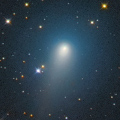
|
It brightened very rapidly and unusually, and reached up to 10 mag. It is bright as 11.2 mag still now (Dec. 2, Juan Jose Gonzalez). It keeps high for a long time in the Northern Hemisphere. But the comet will be fading after this. It locates extremely low in the Southern Hemisphere. The nuclear split was observed in late October.
Date(TT) R.A. (2000) Decl. Delta r Elong. m1 Best Time(A, h)
Dec. 8 0 15.86 41 54.8 0.870 1.598 118 13.0 19:07 (180, 83)
Dec. 15 0 29.60 42 25.3 0.942 1.634 116 13.6 18:53 (180, 82)
|
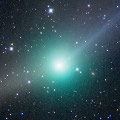
|
It kept as bright as 6-7 mag for a long time from 2011 summer to 2012 spring. Now it is fading. But it is very bright and visible visually at 13.0 mag still now (Nov. 24, Seiichi Yoshida).
Date(TT) R.A. (2000) Decl. Delta r Elong. m1 Best Time(A, h)
Dec. 8 9 56.23 -7 27.5 4.130 4.433 101 13.1 4:49 ( 0, 47)
Dec. 15 9 51.43 -8 15.3 4.082 4.498 108 13.1 4:16 ( 0, 47)
|

|
It brightened up to 11-12 mag in 2012. It is appearing in the morning sky now. It will be observable at 12-13 mag in good condition again in 2013.
Date(TT) R.A. (2000) Decl. Delta r Elong. m1 Best Time(A, h)
Dec. 8 15 31.19 -16 22.4 6.335 5.432 21 13.4 5:25 (292, 3)
Dec. 15 15 32.54 -16 35.1 6.295 5.450 28 13.3 5:30 (297, 8)
|
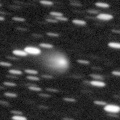
|
Now it is 13.3 mag (Nov. 15, Sandor Szabo). It keeps bright at 13-14 mag for a long time until 2014. It keeps observable for a long time in the Northern Hemisphere. It is not observable in the Southern Hemisphere.
Date(TT) R.A. (2000) Decl. Delta r Elong. m1 Best Time(A, h)
Dec. 8 20 40.65 35 22.4 6.136 6.012 78 13.6 18:18 (103, 56)
Dec. 15 20 42.34 34 18.1 6.209 6.003 73 13.6 18:20 (104, 50)
|
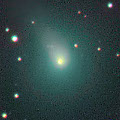
|
It brightened much faster than expected, and reached up to 10.0 mag in summer (Aug. 9, Juan Jose Gonzalez). Now it is fading, but it is bright as 12.9 ma still now (Nov. 24, Seiichi Yoshida). It keeps observable in good condition for a while after this.
Date(TT) R.A. (2000) Decl. Delta r Elong. m1 Best Time(A, h)
Dec. 8 9 24.52 22 3.7 2.046 2.670 119 13.7 4:17 ( 0, 77)
Dec. 15 9 10.73 20 35.4 1.987 2.718 129 13.8 3:36 ( 0, 76)
|

|
Now it is bright and visible visually at 12.2 mag (Nov. 16, Marco Goiato). It keeps 12-14 mag until February. It keeps observable in good condition in the Northern Hemisphere. In the Southern Hemisphere, it will be getting lower gradually after this, and will be unobservable in late January.
Date(TT) R.A. (2000) Decl. Delta r Elong. m1 Best Time(A, h)
Dec. 8 0 1.30 23 14.4 2.652 3.159 112 13.7 18:52 ( 0, 78)
Dec. 15 0 7.79 22 5.6 2.734 3.160 106 13.8 18:31 ( 0, 77)
|
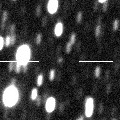
|
First return of a new periodic comet discovered in 1994. Although it had been much fainter than expected, it is brightening rapidly now. Now it is bright as 13.2 mag and visible visually (Nov. 12, Juan Jose Gonzalez). It will be observable at 13 mag in excellent condition from autumn to winter.
Date(TT) R.A. (2000) Decl. Delta r Elong. m1 Best Time(A, h)
Dec. 8 22 50.84 -3 3.2 0.876 1.281 86 13.8 18:18 ( 14, 51)
Dec. 15 23 20.62 -4 50.2 0.906 1.288 85 13.9 18:20 ( 14, 49)
|
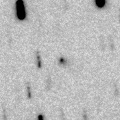
|
Now it is visible visually at 14.7 mag (Nov. 15, Sandor Szabo). It is expected to brighten up to 10 mag from winter to spring in 2013. In the Northern Hemisphere, it keeps observable in good condition until 2013 April. It is not observable now in the Southern Hemisphere. It will become observable after 2013 April, but it keeps locating low.
Date(TT) R.A. (2000) Decl. Delta r Elong. m1 Best Time(A, h)
Dec. 8 22 1.96 76 33.7 2.019 2.515 108 14.0 18:18 (173, 47)
Dec. 15 22 36.42 74 13.8 1.947 2.448 108 13.8 18:20 (172, 50)
|

|
It brightened rapidly, and reached up to 12 mag in 2012. It is not observable now. But it will be observable at 12-14 mag in good condition again in 2013. However, it locates somewhat low in the Northern Hemisphere in 2013.
Date(TT) R.A. (2000) Decl. Delta r Elong. m1 Best Time(A, h)
Dec. 8 16 22.48 -18 19.4 3.859 2.893 9 14.0 5:25 (287, -8)
Dec. 15 16 34.51 -19 4.7 3.837 2.890 13 13.9 5:30 (290, -5)
|
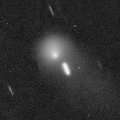
|
Now it is bright as 13.3 mag (Oct. 19, Jakub Cerny). It keeps bright as 13-14 mag for a long time after this until 2013. It is not observable in the Northern Hemisphere, but it is observable in good condition in the Southern Hemisphere.
Date(TT) R.A. (2000) Decl. Delta r Elong. m1 Best Time(A, h)
Dec. 8 3 24.22 -54 25.7 5.748 6.001 100 14.0 22:13 ( 0, 1)
Dec. 15 3 17.19 -53 17.9 5.803 6.022 98 14.1 21:38 ( 0, 2)
|
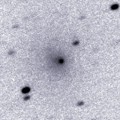
|
Appearing in the morning sky in late November.
Date(TT) R.A. (2000) Decl. Delta r Elong. m1 Best Time(A, h)
Dec. 8 13 47.64 -19 46.9 6.902 6.239 44 14.2 5:25 (312, 18)
Dec. 15 13 51.76 -20 16.7 6.817 6.239 50 14.1 5:30 (318, 22)
|

|
Big asteroid discovered in 1906. It suddenly showed the cometary activity on Dec. 11, 2010, probably due to an impact of a small object. Now it is 11.9 mag (May 29, Marco Goiato). It has already turned to be stellar.
Date(TT) R.A. (2000) Decl. Delta r Elong. m1 Best Time(A, h)
Dec. 8 19 23.19 -30 44.7 3.369 2.598 32 14.3 18:18 ( 49, 3)
Dec. 15 19 37.46 -30 22.4 3.423 2.607 29 14.3 18:20 ( 51, 1)
|
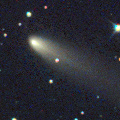
|
First return of a new periodic comet which brightened up to 14 mag in 2005. It brightened very rapidly and became much brighter than originally expected. It is bright as 12.7 mag still now (Nov. 24, Seiichi Yoshida). It keeps high for a long time in the Northern Hemisphere. But the comet will be fading after this. It locates very low in the Southern Hemisphere.
Date(TT) R.A. (2000) Decl. Delta r Elong. m1 Best Time(A, h)
Dec. 8 1 39.27 41 25.0 0.918 1.754 134 14.4 20:29 (180, 84)
Dec. 15 1 46.30 40 52.6 0.990 1.791 130 14.8 20:09 (180, 84)
|
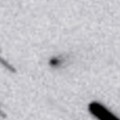
|
It brightened rapidly, and reached up to 15.1 mag in mid November (Nov. 15, Catalina Sky Survey). However, Hidetaka Sato reported that it is 15.8 mag on Dec. 6. Maybe the brightness evolution got slow down. It approaches to the Sun down to 0.3 A.U. in 2013 February. The ephemeris says it will brighten up to 7 mag. However, because the comet is small, it may be disintegrated. It keeps observable in good condition until February while brightening gradually.
Date(TT) R.A. (2000) Decl. Delta r Elong. m1 Best Time(A, h)
Dec. 8 2 8.53 -4 16.0 0.937 1.744 130 14.8 20:56 ( 0, 50)
Dec. 15 1 45.54 -8 59.7 0.930 1.626 116 14.5 20:06 ( 0, 46)
|
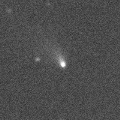
|
Now it is visible visually at 15.0 mag (Nov. 15, Sandor Szabo). It keeps 15 mag until March. In the Northern Hemisphere, it keeps observable for a long time until the comet fades out. It is not observable in the Southern Hemisphere, except for 2013 spring, but the comet locates extremely low only.
Date(TT) R.A. (2000) Decl. Delta r Elong. m1 Best Time(A, h)
Dec. 8 13 51.68 82 30.8 1.771 2.271 107 14.8 5:25 (188, 40)
Dec. 15 13 0.79 86 52.0 1.705 2.266 112 14.7 5:30 (182, 38)
|
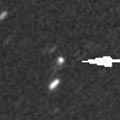
|
It is expected to keep 13 mag and observable in good condition in the Northern Hemisphere for a long time from 2013 to 2014. Now it is 15.4 mag (Nov. 19, V. Gerke, A. Novichonok, S. Plaksa). It will be observable also in the Southern Hemisphere from early December to early March, although it locates low.
Date(TT) R.A. (2000) Decl. Delta r Elong. m1 Best Time(A, h)
Dec. 8 11 32.94 21 39.4 4.736 4.855 91 15.2 5:25 (312, 71)
Dec. 15 11 33.28 22 53.1 4.573 4.814 98 15.1 5:30 (331, 76)
|
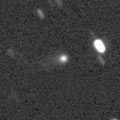
|
Now it is visible visually at 14.4 mag (Nov. 15, Sandor Szabo). It keeps 15-16 mag until February. It keeps observable in good condition for a long time until the comet fades out in the Northern Hemisphere. It is not observable until 2013 summer in the Southern Hemisphere. By the way, Juan Jose Gonzalez reported it extremely bright as 10.4 mag visually on Nov. 6.
Date(TT) R.A. (2000) Decl. Delta r Elong. m1 Best Time(A, h)
Dec. 8 0 7.70 80 50.5 3.018 3.550 115 15.5 18:57 (180, 44)
Dec. 15 0 2.52 76 52.9 3.034 3.556 114 15.5 18:25 (180, 48)
|

|
Now it is 18.0 mag (Nov. 24, J. F. Hernandez). It will brighten very rapidly, and reach up to 13 mag from winter to spring. In the Northern Hemisphere, it keeps observable in excellent condition. In the Southern Hemisphere, it keeps locating extremely low for a while.
Date(TT) R.A. (2000) Decl. Delta r Elong. m1 Best Time(A, h)
Dec. 8 10 10.53 36 32.7 1.722 2.291 112 16.0 5:03 (180, 89)
Dec. 15 10 17.66 36 30.3 1.624 2.257 117 15.7 4:42 (180, 89)
|
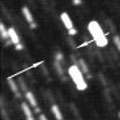
|
Now it is 14.8 mag (Oct. 7, Jakub Cerny). In the Southern Hemisphere, it will be observable at 15-16 mag in good condition for a long time until 2013 summer. It is not observable at all in the Northern Hemisphere.
Date(TT) R.A. (2000) Decl. Delta r Elong. m1 Best Time(A, h)
Dec. 8 21 24.07 -78 54.8 4.356 4.009 63 15.7 18:18 ( 6,-25)
Dec. 15 21 57.53 -78 3.1 4.383 4.024 62 15.8 18:20 ( 6,-24)
|

|
It kept as bright as 11-12 mag for a long time from 2011 autumn to 2012 spring. Now it is fading. It has already faded down to 17.1 mag (Nov. 14, Catalina Sky Survey). It keeps observable in good condition until next spring while the comet will be fading gradually.
Date(TT) R.A. (2000) Decl. Delta r Elong. m1 Best Time(A, h)
Dec. 8 10 35.99 1 57.8 2.881 3.144 96 16.0 5:25 (359, 57)
Dec. 15 10 38.06 1 34.2 2.812 3.176 102 16.1 5:03 ( 0, 57)
|
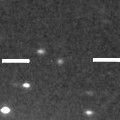
|
Now it is 16.5 mag (Nov. 12, Gerke, A. Novichonok, S. Plaksa). It is expected to be a great comet in 2013 autumn when the comet approaches to the sun down to only 0.01 A.U. It keeps visible with naked eyes from November to January, and can be extremely bright as Venus or more at the highlight. The condition is excellent in the Northern Hemisphere. It keeps observable almost all through the period of brightening, at the highlight, and of fading. The condition is not good in the Southern Hemisphere. It is not observable at all the latter part of the highlight, and it keeps low all through the period.
Date(TT) R.A. (2000) Decl. Delta r Elong. m1 Best Time(A, h)
Dec. 8 8 10.71 29 30.5 4.753 5.513 136 16.3 3:04 ( 0, 84)
Dec. 15 8 6.05 29 51.9 4.606 5.440 144 16.2 2:31 ( 0, 85)
|
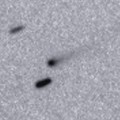
|
Although it had been unobservable for a while, it is appearing in the morning sky now. It keeps bright as 13-14 mag for a long time from 2013 to 2014.
Date(TT) R.A. (2000) Decl. Delta r Elong. m1 Best Time(A, h)
Dec. 8 13 53.65 -6 19.4 4.333 3.741 47 16.5 5:25 (301, 27)
Dec. 15 14 0.83 -6 59.4 4.237 3.726 52 16.4 5:30 (307, 31)
|

|
Now it is 17.0 mag (Nov. 12, Yasukazu Ikari). It will brighten up to 12 mag from summer to autumn in 2013. In the Northern Hemisphere, it is observable only until 2013 spring when the comet brightens up to 15 mag. In the Southern Hemisphere, it keeps unobservable until 2013 August. Then it keeps observable while fading gradually.
Date(TT) R.A. (2000) Decl. Delta r Elong. m1 Best Time(A, h)
Dec. 8 21 57.61 64 7.2 3.133 3.502 103 16.9 18:18 (162, 58)
Dec. 15 22 9.77 62 30.8 3.094 3.433 101 16.8 18:20 (157, 58)
|
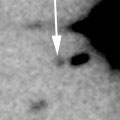
|
Now it is 17.3 mag (Nov. 10, K. Hills). In the Southern Hemisphere, it keeps observable at 17 mag in good condition for a long time from 2012 to 2013. It is not observable at all in the Northern Hemisphere.
Date(TT) R.A. (2000) Decl. Delta r Elong. m1 Best Time(A, h)
Dec. 8 4 57.71 -76 3.2 4.911 4.860 81 17.3 23:43 ( 0,-21)
Dec. 15 4 22.90 -76 24.5 4.932 4.855 79 17.3 22:41 ( 0,-21)
|

|
Now it is 17.5 mag (Dec. 4, Mt. Lemmon Survey). It keeps 17.5 mag until March, and keeps observable in excellent condition in the Northern Hemisphere. It locates low in the Southern Hemisphere.
Date(TT) R.A. (2000) Decl. Delta r Elong. m1 Best Time(A, h)
Dec. 8 7 19.89 28 28.5 1.599 2.490 147 17.5 2:13 ( 0, 83)
Dec. 15 7 17.12 29 36.6 1.550 2.479 155 17.4 1:43 ( 0, 85)
|

|
Although it was 18.7 mag on Oct. 18 (Siding Spring Survey), it brightened rapidly up to 17.2 mag (Dec. 4, Hidetaka Sato). It will be observable at 17.5 mag in good condition until February.
Date(TT) R.A. (2000) Decl. Delta r Elong. m1 Best Time(A, h)
Dec. 8 0 13.49 -23 42.1 1.552 1.929 96 17.7 19:04 ( 0, 32)
Dec. 15 0 16.62 -19 46.0 1.595 1.907 92 17.6 18:39 ( 0, 36)
|
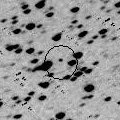
|
Peculiar asteroid moving along a cometary orbit. It keeps observable at 18 mag for a long time from 2008 to 2014. It locates extremely low in the Southern Hemisphere.
Date(TT) R.A. (2000) Decl. Delta r Elong. m1 Best Time(A, h)
Dec. 8 7 55.56 36 31.7 6.308 7.088 139 17.7 2:48 (180, 89)
Dec. 15 7 50.97 37 20.7 6.256 7.100 146 17.6 2:16 (180, 88)
|
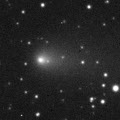
|
It brightened up to 12 mag in 2010. Now the comet is around the aphelion. But it will be observable at 17.5 mag in good condition from autumn to winter. However, now it is 18.8 mag (Nov. 18, Gerke, A. Novichonok, S. Plaksa), much fainter than this ephemeris.
Date(TT) R.A. (2000) Decl. Delta r Elong. m1 Best Time(A, h)
Dec. 8 4 8.88 20 44.3 3.702 4.670 168 17.7 22:58 ( 0, 76)
Dec. 15 4 4.20 20 39.8 3.742 4.678 159 17.7 22:26 ( 0, 76)
|
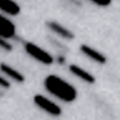
|
Now it is 17.5 mag (Nov. 10, J. Lozano). It keeps 17-18 mag for a long time until the end of 2013. The condition is good in the Northern Hemisphere. It is hardly observable in 2012 in the Northern Hemisphere. But it will be observable in good condition in 2013.
Date(TT) R.A. (2000) Decl. Delta r Elong. m1 Best Time(A, h)
Dec. 8 23 25.49 39 59.2 4.237 4.654 109 17.8 18:18 (174, 85)
Dec. 15 23 24.48 37 50.6 4.314 4.634 102 17.8 18:20 (115, 83)
|
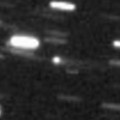
|
Now it is 17.9 mag (Nov. 1, P. Dupouy, J. B. de Vanssay). It reached up to 17 mag in last winter between 2011 and 2012. It will be observable in good condition again at 17.5 mag in this winter.
Date(TT) R.A. (2000) Decl. Delta r Elong. m1 Best Time(A, h)
Dec. 8 9 43.90 15 31.2 3.619 4.106 113 17.9 4:36 ( 0, 70)
Dec. 15 9 44.23 15 30.7 3.531 4.114 120 17.8 4:09 ( 0, 70)
|

|
First return of a new periodic comet discovered in 1997 at 17 mag. Now it is 18.1 mag (Nov. 14, R. Ligustri). It was expected to keep 17 mag for a long time from 2012 to 2014. But actually, it is fainter than predicted by 1-2 mag.
Date(TT) R.A. (2000) Decl. Delta r Elong. m1 Best Time(A, h)
Dec. 8 1 51.10 11 43.9 3.084 3.832 133 19.1 20:41 ( 0, 67)
Dec. 15 1 50.50 11 35.9 3.149 3.818 126 19.1 20:13 ( 0, 67)
|
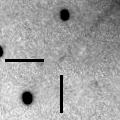
|
It was observed at 17 mag in 2011 autumn. It was expected to be observable at 17 mag in good condition again from autumn to winter in 2012. But actually, the comet is 19.9 mag (Nov. 27, Mt. Lemmon Survey), much fainter than this ephemeris. The comet must have faded out very rapidly.
Date(TT) R.A. (2000) Decl. Delta r Elong. m1 Best Time(A, h)
Dec. 8 6 35.02 36 15.8 2.265 3.187 155 20.5 1:28 (180, 89)
Dec. 15 6 28.60 37 36.2 2.263 3.209 161 20.6 0:54 (180, 87)
|
|
![]()
 C/2011 L4 ( PanSTARRS )
C/2011 L4 ( PanSTARRS ) C/2012 K5 ( LINEAR )
C/2012 K5 ( LINEAR ) C/2011 F1 ( LINEAR )
C/2011 F1 ( LINEAR ) C/2012 F6 ( Lemmon )
C/2012 F6 ( Lemmon ) C/2011 R1 ( McNaught )
C/2011 R1 ( McNaught ) 168P/Hergenrother
168P/Hergenrother C/2009 P1 ( Garradd )
C/2009 P1 ( Garradd ) C/2006 S3 ( LONEOS )
C/2006 S3 ( LONEOS ) C/2010 S1 ( LINEAR )
C/2010 S1 ( LINEAR ) C/2011 UF305 ( LINEAR )
C/2011 UF305 ( LINEAR ) C/2012 J1 ( Catalina )
C/2012 J1 ( Catalina ) 262P/2012 K7 ( McNaught-Russell )
262P/2012 K7 ( McNaught-Russell ) C/2012 L2 ( LINEAR )
C/2012 L2 ( LINEAR ) 246P/2010 V2 ( NEAT )
246P/2010 V2 ( NEAT ) C/2009 F4 ( McNaught )
C/2009 F4 ( McNaught ) 29P/Schwassmann-Wachmann 1
29P/Schwassmann-Wachmann 1 (596) Scheila
(596) Scheila 260P/2012 K2 ( McNaught )
260P/2012 K2 ( McNaught ) C/2012 T5 ( Bressi )
C/2012 T5 ( Bressi ) C/2012 L1 ( LINEAR )
C/2012 L1 ( LINEAR ) C/2011 J2 ( LINEAR )
C/2011 J2 ( LINEAR ) C/2012 A2 ( LINEAR )
C/2012 A2 ( LINEAR ) 63P/Wild 1
63P/Wild 1 C/2011 O1 ( LINEAR )
C/2011 O1 ( LINEAR ) 78P/Gehrels 2
78P/Gehrels 2 C/2012 S1 ( ISON )
C/2012 S1 ( ISON ) 117P/Helin-Roman-Alu 1
117P/Helin-Roman-Alu 1 C/2012 V2 ( LINEAR )
C/2012 V2 ( LINEAR ) C/2012 C1 ( McNaught )
C/2012 C1 ( McNaught ) P/2012 WX32 ( Tenagra )
P/2012 WX32 ( Tenagra ) P/2012 US27 ( Siding Spring )
P/2012 US27 ( Siding Spring ) 2008 YB3
2008 YB3 65P/Gunn
65P/Gunn C/2012 S4 ( PanSTARRS )
C/2012 S4 ( PanSTARRS ) 244P/2010 Q1 ( Scotti )
244P/2010 Q1 ( Scotti ) 270P/2012 S5 ( Gehrels )
270P/2012 S5 ( Gehrels ) P/2011 N1 ( ASH )
P/2011 N1 ( ASH )![]()































